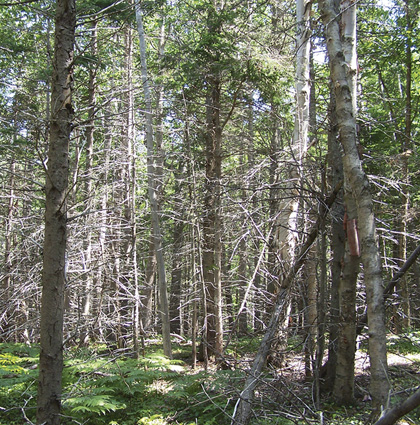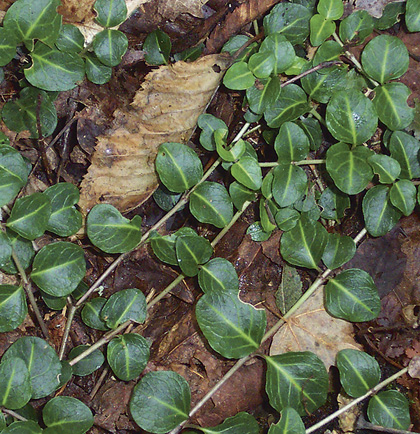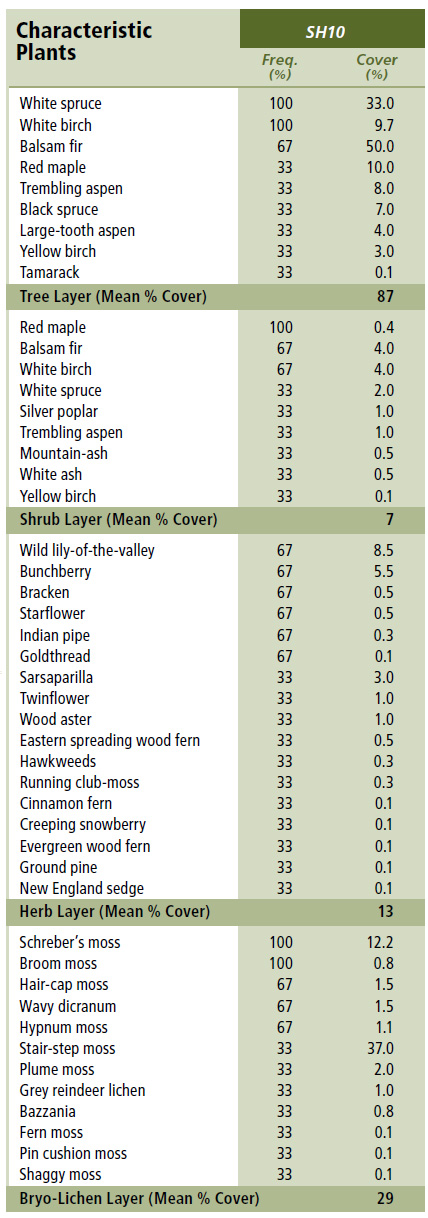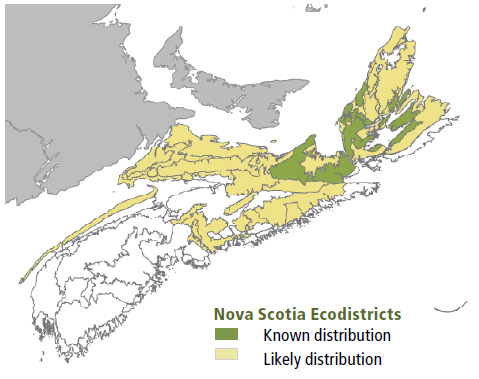
Forest Vegetation types - SH10
SH10 — White spruce – Balsam fir / Broom moss
Picea glauca – Abies balsamea /Dicranum scoparium
 |
Georgeville, Antigonish County |
Concept: This mid-successional Vegetation Type (VT) has an overstory of white spruce and balsam fir along with a component of white birch (its relative abundance reflects time since disturbance). The absence of white spruce in the understory suggests this species will not form a significant part of later successional stages. White spruce – Balsam fir / Broom moss usually follows stand-replacing disturbance events such as insect infestation, windthrow or harvesting.
Vegetation: White spruce, balsam fir and white birch are the main overstory trees, but stands may also contain minor amounts of red maple and yellow birch. The shrub layer is completely made up of regenerating tree species, especially balsam fir. Both the herb and bryophyte layers have low species diversity and abundance. Typical upland forest flora are present including wild lily-of-the-valley, bunchberry, Schreber's moss and wavy dicranum.
Environmental Setting: SH10 is mainly associated with fresh to fresh-moist, nutrient medium soils of glacial origin. These soils are generally medium to coarse textured. This VT is most common in eastern Nova Scotia, particularly the Eastern Interior ecodistrict where white spruce often replaces red spruce in spruce-fir stands.
Successional Dynamics: SH10 is a predominantly even-aged, mid-successional VT dominated by white spruce and balsam fir. This VT usually follows stand-replacing disturbances from insect infestation, windthrow or harvesting. Early successional stages may have an increased proportion of white birch. In the absence of stand-level disturbance, white spruce and balsam fir in this VT will eventually succumb to agents such as bark beetle, tussock moth and disease allowing red maple and yellow birch to increase in dominance. Possible later successional VTs include MW1 (Red spruce – Yellow birch /Evergreen wood fern) and TH7 (Yellow birch – White birch / Evergreen wood fern).
Ecological Features: This is a large-patch closed canopy forest with limited distribution in eastern Nova Scotia. Balsam fir is very shade-tolerant and capable of regenerating extensively in the understory, while white spruce is slightly less tolerant. Mature forests may provide habitat for red squirrels and flying squirrels. South facing slopes may provide winter cover for deer. Understory fir snags are favoured habitat for small cavity nesting songbirds. Young forests are preferred habitat for snowshoe hare. These forests may support abundant fruiting of mycorrhizal mushrooms, including chanterelles and boletes. No plant or lichen species of conservation concern were found in available plot data.
 |
| Partridge-berry |
Distinguishing Features: White spruce growing with balsam fir and lesser white birch is diagnostic of this softwood forest usually found in eastern Nova Scotia.
| Slope Position: | Upper3 Middle3 Lower3 |
Surface Stoniness: |
(Non - Slightly)10 |
Bedrock Outcrop: |
(Non-rocky)10 |
Elevation Range: |
100 - 159m |
Slope Gradient: |
Gentle10 |
Aspect: |
North7 South3 |
Exposure: |
Moderate7 Mod. exposed3 |
Microtopography: |
Moderately7 Slightly3 |
Drainage: |
Moderately well7 Well3 |
Soil Type: |
ST2-L3 ST33 ST53 |
Parent Material: |
Glacial till10 |
Rooting Depth (cm): |
(<30)3 (30-45)3 (>45)3 |
Duff Thickness (cm): |
(6-10)7 (11-20)3 |

